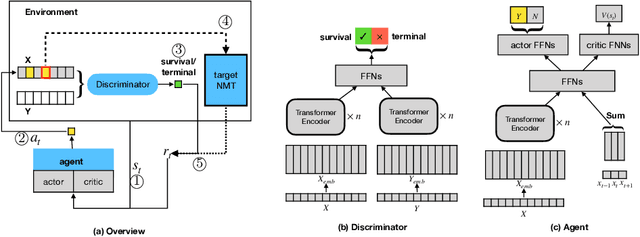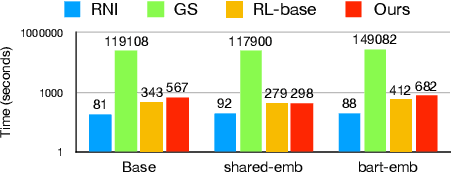Wei Zou
AudioStory: Generating Long-Form Narrative Audio with Large Language Models
Aug 27, 2025Abstract:Recent advances in text-to-audio (TTA) generation excel at synthesizing short audio clips but struggle with long-form narrative audio, which requires temporal coherence and compositional reasoning. To address this gap, we propose AudioStory, a unified framework that integrates large language models (LLMs) with TTA systems to generate structured, long-form audio narratives. AudioStory possesses strong instruction-following reasoning generation capabilities. It employs LLMs to decompose complex narrative queries into temporally ordered sub-tasks with contextual cues, enabling coherent scene transitions and emotional tone consistency. AudioStory has two appealing features: (1) Decoupled bridging mechanism: AudioStory disentangles LLM-diffuser collaboration into two specialized components, i.e., a bridging query for intra-event semantic alignment and a residual query for cross-event coherence preservation. (2) End-to-end training: By unifying instruction comprehension and audio generation within a single end-to-end framework, AudioStory eliminates the need for modular training pipelines while enhancing synergy between components. Furthermore, we establish a benchmark AudioStory-10K, encompassing diverse domains such as animated soundscapes and natural sound narratives. Extensive experiments show the superiority of AudioStory on both single-audio generation and narrative audio generation, surpassing prior TTA baselines in both instruction-following ability and audio fidelity. Our code is available at https://github.com/TencentARC/AudioStory
TracLLM: A Generic Framework for Attributing Long Context LLMs
Jun 06, 2025Abstract:Long context large language models (LLMs) are deployed in many real-world applications such as RAG, agent, and broad LLM-integrated applications. Given an instruction and a long context (e.g., documents, PDF files, webpages), a long context LLM can generate an output grounded in the provided context, aiming to provide more accurate, up-to-date, and verifiable outputs while reducing hallucinations and unsupported claims. This raises a research question: how to pinpoint the texts (e.g., sentences, passages, or paragraphs) in the context that contribute most to or are responsible for the generated output by an LLM? This process, which we call context traceback, has various real-world applications, such as 1) debugging LLM-based systems, 2) conducting post-attack forensic analysis for attacks (e.g., prompt injection attack, knowledge corruption attacks) to an LLM, and 3) highlighting knowledge sources to enhance the trust of users towards outputs generated by LLMs. When applied to context traceback for long context LLMs, existing feature attribution methods such as Shapley have sub-optimal performance and/or incur a large computational cost. In this work, we develop TracLLM, the first generic context traceback framework tailored to long context LLMs. Our framework can improve the effectiveness and efficiency of existing feature attribution methods. To improve the efficiency, we develop an informed search based algorithm in TracLLM. We also develop contribution score ensemble/denoising techniques to improve the accuracy of TracLLM. Our evaluation results show TracLLM can effectively identify texts in a long context that lead to the output of an LLM. Our code and data are at: https://github.com/Wang-Yanting/TracLLM.
SARI: Structured Audio Reasoning via Curriculum-Guided Reinforcement Learning
Apr 22, 2025Abstract:Recent work shows that reinforcement learning(RL) can markedly sharpen the reasoning ability of large language models (LLMs) by prompting them to "think before answering." Yet whether and how these gains transfer to audio-language reasoning remains largely unexplored. We extend the Group-Relative Policy Optimization (GRPO) framework from DeepSeek-R1 to a Large Audio-Language Model (LALM), and construct a 32k sample multiple-choice corpus. Using a two-stage regimen supervised fine-tuning on structured and unstructured chains-of-thought, followed by curriculum-guided GRPO, we systematically compare implicit vs. explicit, and structured vs. free form reasoning under identical architectures. Our structured audio reasoning model, SARI (Structured Audio Reasoning via Curriculum-Guided Reinforcement Learning), achieves a 16.35% improvement in average accuracy over the base model Qwen2-Audio-7B-Instruct. Furthermore, the variant built upon Qwen2.5-Omni reaches state-of-the-art performance of 67.08% on the MMAU test-mini benchmark. Ablation experiments show that on the base model we use: (i) SFT warm-up is important for stable RL training, (ii) structured chains yield more robust generalization than unstructured ones, and (iii) easy-to-hard curricula accelerate convergence and improve final performance. These findings demonstrate that explicit, structured reasoning and curriculum learning substantially enhances audio-language understanding.
Trans-Zero: Self-Play Incentivizes Large Language Models for Multilingual Translation Without Parallel Data
Apr 20, 2025Abstract:The rise of Large Language Models (LLMs) has reshaped machine translation (MT), but multilingual MT still relies heavily on parallel data for supervised fine-tuning (SFT), facing challenges like data scarcity for low-resource languages and catastrophic forgetting. To address these issues, we propose TRANS-ZERO, a self-play framework that leverages only monolingual data and the intrinsic multilingual knowledge of LLM. TRANS-ZERO combines Genetic Monte-Carlo Tree Search (G-MCTS) with preference optimization, achieving strong translation performance that rivals supervised methods. Experiments demonstrate that this approach not only matches the performance of models trained on large-scale parallel data but also excels in non-English translation directions. Further analysis reveals that G-MCTS itself significantly enhances translation quality by exploring semantically consistent candidates through iterative translations, providing a robust foundation for the framework's succuss.
Aligned Better, Listen Better for Audio-Visual Large Language Models
Apr 02, 2025Abstract:Audio is essential for multimodal video understanding. On the one hand, video inherently contains audio, which supplies complementary information to vision. Besides, video large language models (Video-LLMs) can encounter many audio-centric settings. However, existing Video-LLMs and Audio-Visual Large Language Models (AV-LLMs) exhibit deficiencies in exploiting audio information, leading to weak understanding and hallucinations. To solve the issues, we delve into the model architecture and dataset. (1) From the architectural perspective, we propose a fine-grained AV-LLM, namely Dolphin. The concurrent alignment of audio and visual modalities in both temporal and spatial dimensions ensures a comprehensive and accurate understanding of videos. Specifically, we devise an audio-visual multi-scale adapter for multi-scale information aggregation, which achieves spatial alignment. For temporal alignment, we propose audio-visual interleaved merging. (2) From the dataset perspective, we curate an audio-visual caption and instruction-tuning dataset, called AVU. It comprises 5.2 million diverse, open-ended data tuples (video, audio, question, answer) and introduces a novel data partitioning strategy. Extensive experiments show our model not only achieves remarkable performance in audio-visual understanding, but also mitigates potential hallucinations.
Monocular Depth Estimation and Segmentation for Transparent Object with Iterative Semantic and Geometric Fusion
Feb 20, 2025Abstract:Transparent object perception is indispensable for numerous robotic tasks. However, accurately segmenting and estimating the depth of transparent objects remain challenging due to complex optical properties. Existing methods primarily delve into only one task using extra inputs or specialized sensors, neglecting the valuable interactions among tasks and the subsequent refinement process, leading to suboptimal and blurry predictions. To address these issues, we propose a monocular framework, which is the first to excel in both segmentation and depth estimation of transparent objects, with only a single-image input. Specifically, we devise a novel semantic and geometric fusion module, effectively integrating the multi-scale information between tasks. In addition, drawing inspiration from human perception of objects, we further incorporate an iterative strategy, which progressively refines initial features for clearer results. Experiments on two challenging synthetic and real-world datasets demonstrate that our model surpasses state-of-the-art monocular, stereo, and multi-view methods by a large margin of about 38.8%-46.2% with only a single RGB input. Codes and models are publicly available at https://github.com/L-J-Yuan/MODEST.
Extend Adversarial Policy Against Neural Machine Translation via Unknown Token
Jan 21, 2025



Abstract:Generating adversarial examples contributes to mainstream neural machine translation~(NMT) robustness. However, popular adversarial policies are apt for fixed tokenization, hindering its efficacy for common character perturbations involving versatile tokenization. Based on existing adversarial generation via reinforcement learning~(RL), we propose the `DexChar policy' that introduces character perturbations for the existing mainstream adversarial policy based on token substitution. Furthermore, we improve the self-supervised matching that provides feedback in RL to cater to the semantic constraints required during training adversaries. Experiments show that our method is compatible with the scenario where baseline adversaries fail, and can generate high-efficiency adversarial examples for analysis and optimization of the system.
* accepted by CCMT 2024()
C3oT: Generating Shorter Chain-of-Thought without Compromising Effectiveness
Dec 16, 2024



Abstract:Generating Chain-of-Thought (CoT) before deriving the answer can effectively improve the reasoning capabilities of large language models (LLMs) and significantly improve the accuracy of the generated answer. However, in most cases, the length of the generated CoT is much longer than the desired final answer, which results in additional decoding costs. Furthermore, existing research has discovered that shortening the reasoning steps in CoT, even while preserving the key information, diminishes LLMs' abilities. These phenomena make it difficult to use LLMs and CoT in many real-world applications that only require the final answer and are sensitive to latency, such as search and recommendation. To reduce the costs of model decoding and shorten the length of the generated CoT, this paper presents $\textbf{C}$onditioned $\textbf{C}$ompressed $\textbf{C}$hain-of-$\textbf{T}$hought (C3oT), a CoT compression framework that involves a compressor to compress an original longer CoT into a shorter CoT while maintaining key information and interpretability, a conditioned training method to train LLMs with both longer CoT and shorter CoT simultaneously to learn the corresponding relationships between them, and a conditioned inference method to gain the reasoning ability learned from longer CoT by generating shorter CoT. We conduct experiments over four datasets from arithmetic and commonsense scenarios, showing that the proposed method is capable of compressing the length of generated CoT by up to more than 50% without compromising its effectiveness.
Advancing Speech Language Models by Scaling Supervised Fine-Tuning with Over 60,000 Hours of Synthetic Speech Dialogue Data
Dec 03, 2024



Abstract:The GPT-4o represents a significant milestone in enabling real-time interaction with large language models (LLMs) through speech, its remarkable low latency and high fluency not only capture attention but also stimulate research interest in the field. This real-time speech interaction is particularly valuable in scenarios requiring rapid feedback and immediate responses, dramatically enhancing user experience. However, there is a notable lack of research focused on real-time large speech language models, particularly for Chinese. In this work, we present KE-Omni, a seamless large speech language model built upon Ke-SpeechChat, a large-scale high-quality synthetic speech interaction dataset consisting of 7 million Chinese and English conversations, featuring 42,002 speakers, and totaling over 60,000 hours, This contributes significantly to the advancement of research and development in this field. The demos can be accessed at \url{https://huggingface.co/spaces/KE-Team/KE-Omni}.
PhaGO: Protein function annotation for bacteriophages by integrating the genomic context
Aug 12, 2024Abstract:Bacteriophages are viruses that target bacteria, playing a crucial role in microbial ecology. Phage proteins are important in understanding phage biology, such as virus infection, replication, and evolution. Although a large number of new phages have been identified via metagenomic sequencing, many of them have limited protein function annotation. Accurate function annotation of phage proteins presents several challenges, including their inherent diversity and the scarcity of annotated ones. Existing tools have yet to fully leverage the unique properties of phages in annotating protein functions. In this work, we propose a new protein function annotation tool for phages by leveraging the modular genomic structure of phage genomes. By employing embeddings from the latest protein foundation models and Transformer to capture contextual information between proteins in phage genomes, PhaGO surpasses state-of-the-art methods in annotating diverged proteins and proteins with uncommon functions by 6.78% and 13.05% improvement, respectively. PhaGO can annotate proteins lacking homology search results, which is critical for characterizing the rapidly accumulating phage genomes. We demonstrate the utility of PhaGO by identifying 688 potential holins in phages, which exhibit high structural conservation with known holins. The results show the potential of PhaGO to extend our understanding of newly discovered phages.
 Add to Chrome
Add to Chrome Add to Firefox
Add to Firefox Add to Edge
Add to Edge